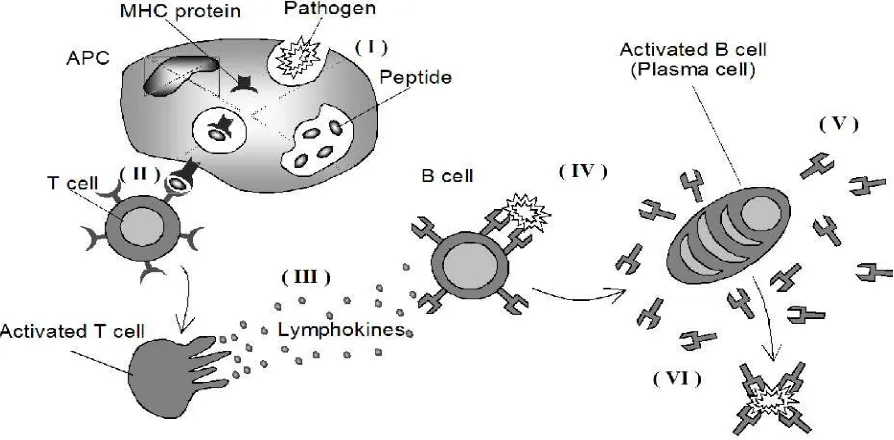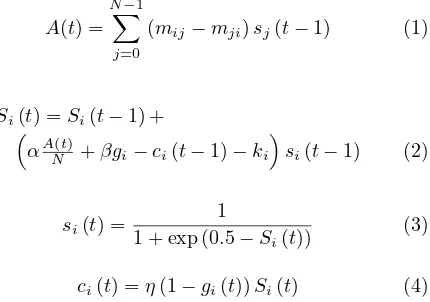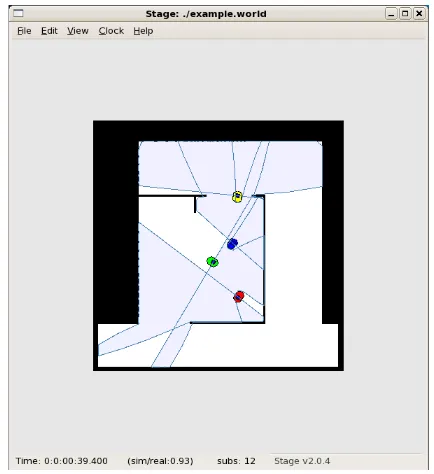MEMORY-BASED IMMUNE NETWORK FOR MULTI-ROBOT COOPERATION
Sazalinsyah RazaliQinggang Meng Shuang-Hua Yang
Department of Computer Science Loughborough University Loughborough, Leicestershire
LE11 3TU United Kingdom
E-mail: {S.Razali|Q.Meng|S.H.Yang}@lboro.ac.uk
KEYWORDS
Multi-robot, Immune Systems, Cooperation, Memory, Simulation
ABSTRACT
In this paper, basic biological immune systems and their responses to external elements to maintain an organ-ism’s health state are fully described. The relationship between immune systems and multi-robot systems are also discussed. Our proposed algorithm is based on im-mune network theories that have many similarities with the multi-robot systems domain. The paper describes a memory-based immune network that enhance a robot’s action-selection process and can obtain an overall a quick group response. The algorithm which is named as
Immune Network T-cell-regulated—with Memory (INT-M) is applied to the dog and sheep scenario. Simulation experiments are being conducting on the Player/Stage platform and experimental data are being evaluated.
INTRODUCTION
Usually mobile robots need to interact and engage with one another in order to achieve assigned tasks more ef-ficiently. These autonomous multi-robot systems would be highly beneficial in assisting humans to complete suitable tasks. In such systems, distributed intelligence is highly needed in the team whereby decisions are pro-cessed in each individual robots (Parker 1998). Further-more, these robots would need to have the mechanism to cooperate so that they would achieve the assigned task (Cao et al. 1997).
Biological systems are examples of distributed informa-tion processing that are capable of solving problems in living organisms in a distributed manner. Some of these biological systems have neural networks in the brain that is capable of processing information through impulses at the synapses, genetic systems in constructing the or-ganism genes and immune systems which protect and
maintain the homeostatic state of the living organism. Biological immune systems are particularly interesting, not only because they have no central processing but also exhibit cooperative capability among the antibod-ies in maintaining the internal stable environment of the body.
This leads to the advances in research on Artificial Immune Systems (AIS) and the application of AIS in engineering fields particularly in Multi-Robot Systems (MRS) domain (Cao et al. 1997, Li et al. 2007, Parker 1998). Situations faced by multi-robot systems require real-time processing and response. Furthermore, such situations would also require these systems to be robust to changes in the environment and some unexpected events, such as failure of robots in the team. Thus, mimicking the biological immune system is appropriate.
This paper proposes a memory-enhanced immune sys-tem algorithm to achieve cooperative behavior in a team of robots. Using the algorithm inspired by the immune network theory, the robots have the capability of per-forming their mission in a dynamically changing envi-ronment. The proposed algorithm is applied to the dog and sheep scenario (Li et al. 2007, Schultz et al. 1996). Simulation experiments are arranged to investigate the proposed algorithm using the above scenario.
The proposed approach would be suitable in various application domains such as military, disaster rescue operation and even service robotics in domestic envi-ronment. These example applications usually require several robots and have continuously changing environ-ments. The test scenario can be extended for the chosen application domain.
BACKGROUND
immune systems in vertebrate organisms. This is fol-lowed by the generic relation between immune systems and multi-robot systems.
Biological Immune Systems
Immune system is a system that eliminates foreign stances from an organism’s body. These foreign sub-stances such as bacteria, fungi or virus cells that can harm the host are called pathogens. When such sub-stance activates an immune response it is called anti-gen, which stimulates the system’s antibody generation. Each antigen has a unique set of identification on its sur-face called epitope. These antigenic determinants are where the host’s antibodies would attach to by using their paratope, as shown in Figure 1. Antibodies are cells in the immune system that kill antigens in order to maintain the host homeostatic state—i.e. balancing the body’s health status.
Figure 1: Antigen-antibody binding and Jerne’s Idio-typic Network Theory
The immune system can be divided into two general categories, innate immunity and adaptive immunity. In-nate immunity is the first line of defense of the immune system. Generic pathogens that can be recognized and killed by the innate immunity cells would not be able to harm the host further. However, certain disease carrying antigens would bypass this defense mechanism because the innate immunity does not adapt to antigens that originate from various types of illnesses. The adaptive immunity would then play its role through the use of
lymphocytes which are generally known as white blood cells. Lymphocytes have two main types, T-cells that mainly help in recognizing antigen cells andB-cells that mainly produce antibodies to fight specific antigens. In humans, T-cells are primarily produced in the thymus while B-cells are produced in bone marrows. These in-nate and adaptive immune responses make up effective
and important defense mechanism for living organisms.
Immune Response
The immune response basically can be viewed in six phases of recognition and activation, as seen in Fig-ure 2. Pathogen is digested by Antigen Presenting Cells (APCs) where it is broken down intopeptides (de Cas-tro and Timmis 2002). These peptides will then bind to Major Histocompatibility Complex (MHC) molecules, then presented on the APC surface. T-cells recognize these different APC receptors and thus become acti-vated. They divide and releaselymphokines that trans-mit chemical signals to stimulate other immune system components to take action. B-cells would then travel to the affected area and be able to recognize the antigen. This would activate the B-cells which then mature into
plasma cells. Plasma cells are the ones which release specific antibody molecules that neutralize the particu-lar pathogens.
This immune response cycle results in the host’s im-munity against the antigen which triggers it, thus hav-ing protection in future attacks (de Castro and Timmis 2002). Prominent characteristics of the immune system is that there is no central control of the lymphocytes in fighting antigens that invade the host and the system’s adaptability in responding to various kind of antigens. The B-cells cooperatively merge at the affected area and produce appropriate antibodies for that particular situ-ation. This phase of immune response exhibits cooper-ative behavior of the related cells.
Idiotypic Network Hypothesis
Studies in immunology have suggested that antibodies are not isolated but they ‘communicate’ with each other. Each type of antibody has its specific idiotope, an anti-gen determinant as shown in Figure 1. Jerne (1984) who is an immunologist proposed the Idiotypic Network Hypothesis (also known as Idiotypic Network Theory) which views the immune system as a large-scale closed system consisting of interaction of various lymphocytes (i.e. B-cells). Referring to Figure 1, idiotope of anti-body i stimulates antibody i+1 through its paratope. Antibody i+1 views that idiotope (belonging to anti-bodyi) simultaneously as an antigen. Thus, antibodyi
is suppressed by antibody i+1. These mutual stimu-lation and suppression chains between antibodies form a controlling mechanism for the immune response (de Castro and Timmis 2002).
Figure 2: Basic biological immune systems response (de Castro and Timmis 2002)
interaction is the main mechanism that can be used for cooperation of multi-robot systems.
Immune Systems and MRS
The relationship of the immune systems with multi-robot systems is evident where obstacles, multi-robots and their responses are antigens, B-cells and antibodies re-spectively. Table 1 lists the obvious parallel of MRS and immune systems terminologies.
Table 1: Immune Systems and MRS relationship
Immune Systems Multi-Robot Systems
B-cell Robot
Antigen Robot’s Environment Antibody Robot’s action
T-cell Control parameter
Plasma cell Excellent robot Inactivated cell Inferior robot Immune network Robots interaction
Stimulus Adequate robot stimulation Suppression Inadequate robot stimulation
Immune network theory as previously described is suit-able as a basis for emulating cooperative behavior in a multi-robot environment. This is because the immune network uses affinity measures that are dependent on other cells concentration and location in determining the next action. Other than that, multi-robot systems re-quire recognition ability of obstacles and other robots, which is parallel to the immune system recognition and activation phase of an immune response. Obviously, in immune network the processing of information is done
in real-time and in a distributed manner—as what a multi-robot system requires.
IMMUNE NETWORK BASED
MULTI-ROBOT COOPERATION
Sun et al. (2001) have proposed a model based on Farmer’s immune network equation that involves T-cells as control parameter which provides adaptation ability in group behaviour.
The group control or coordination phase is done in a distributed manner via local communication between nearby robots. When a robot encounters other robot and both have the same or similar strategy, this strat-egy is stimulated; if not, the stratstrat-egy is suppressed. This facilitates the group to self-organize towards a common action which is optimal for the local environment. If a robot is stimulated beyond a certain threshold—which makes it an excellent robot, its behaviour is regarded as adequate in the system such that it can transmit its strategy to other inferior robots. This is a metaphor of the plasma cell in the biological immune systems.
The advantage of adding the T-cell model is that the system adapts quickly to the environment by recovery of antibody concentration to the initial state, when anti-gens have successfully been removed. Thus, the system is more adaptable to environmental changes.
IMMUNE NETWORK WITH MEMORY
In biological immune response, there is a Clonal Selec-tion process, whereby various B-cells try to identify the antigen. Once the appropriate B-cell is selected, it is ac-tivated and multiplied (i.e. proliferate) so that adequate immune response could be mounted later. The activated B-cells will proliferate and differentiate into Plasma cells that will secrete specific antibodies and memory cells which will be in the host body for quite a long time (de Castro and Timmis 2002). These memory cells will act as catalysts in mounting a quick immune response to the same antigen in the future.
The INT-M Model
In order to improve the approach by Sun et al. (2001), a specific memory mechanism is proposed in order to retain the appropriate action for relevant environment condition. This mechanism is introduced when the newly sensed environment is similar to the previous en-vironment. Thus, a quick action-selection process can be executed without the need of re-evaluating the new situation.
The approach is aptly named as Immune Network T-cell-regulated—with Memory (INT-M) as it involves modelling the memory part of the biological immune systems. The general algorithm is shown in algorithm 1 which is an extension of Sun et al. (2001). The algo-rithm being displayed is for each robot in the group, and uses Equations (2), (3) and (4).
A(t) =
In equations (2) and (3), Si(t) is the stimulus value of antibody iwherei, j = 0. . . N, N is the number of an-tibody types. mij is the mutual stimulus of antibodyi and j, which is referred to in Table 2. gi is the affin-ity of antibody iand antigen, which can arbitrarily be assigned using a function. si(t) is the concentration of antibody i. The difference with Farmer et al. (1987) immune network equation is that sj(t) is not the con-centration of self-antibody, but that of other robot’s an-tibody obtained by communication.
Table 2: Mutual stimulus coefficient,mij robot i\robotj Ab0 Ab1 Ab2 Ab3 Aggregation,Ab0 1 -0.4 -0.2 -0.4
Search,Ab1 -0.4 1 -0.4 -0.2 Dispersion,Ab2 -0.2 -0.4 1 -0.4 Homing,Ab3 -0.4 -0.2 -0.4 1
Equation (4) is the T-cell model whereby ci(t) is the concentration of T-cell which controls the concentration of antibody i. α, β, and η are constants, whereby α and β are parameters of response rate of other robot and the environment (antigen) respectively. In biologi-cal immune systems, helper T-cells activate B-cells when antigen invades, and suppressor T-cells prevent the ac-tivation of B-cells when the antigen has been eliminated thus ensuring that the system adapts quickly to the en-vironment by recovery of antibody concentration to the initial state.
Equations (5) and (6) are the functions and its corre-sponding values for the upper (τ) and lower (τ) thresh-olds in determining whether a robot becomes an excel-lent (i.e. plasma cell) or an inferior (i.e. inactivated cell) robot.
In this research we investigate shepherding behavior of robots. Shepherding behavior is similar to a flocking behavior but having agents/robots outside of the flock guiding or controlling the members (Lien et al. 2004). Figure 3 shows the screenshot of the dog and sheep sce-nario.
In a dog and sheep problem, a few dogs try to guide a few sheep to the grazing site (also called the safety zone) without going beyond the borders (Schultz et al. 1996). Dogs are required to cooperate in shepherding the sheep which are moving away from the dogs or wandering ran-domly inside the area. The objective is to prevent the sheep from going out of the grazing site while having partial information of what is happening in the area.
Algorithm 1Immune Network T-cell-regulated—with Memory (INT-M)
Require: t= 0, Si(0) =si(0) = 0.5 fori= 0. . . N−1, N is number of actions
Ensure: retain previous Ab if robot is not inferior within similar environment, execute Abmax
Abmax←Ab1
robot ←inferior environment←similar
loop
ExecuteAbmax
{robot is activated (normal) or excellent}
if robot6= inferiorthen
{environment sensed issimilar to previous}
if gi(t)≈gi(t−1)then
Si(t)←Si(t−1) si(t)←si(t−1) ci(t)←ci(t−1)
else
environment←changed
end if end if
{robot is inferior or environment has changed}
if (robot=inferior)k(environment=changed)then fori←0 toN−1 do
Calculate Si(t) Calculate si(t) Calculate ci(t)
end for
if Si(t)>τ¯then
robot ←excellent
else if Si(t)< τ then
robot ←inferior
if robot encounterrobotexcellent then for allido
receiveAbi renewsi(t)
end for end if end if end if
if Abi hasmax(si(t))then
Abmax←Abi
end if
t←t+ 1
end loop
Figure 3: The Dog and Sheep problem environment
The proposed approach as described in algorithm 1 is applied to the dog and sheep problem and adjusted where necessary. The Player/Stage simulation plat-form (Gerkey et al. 2003) on a Fedora Core 6 Linux operating system is being used to test the proposed al-gorithm. Figure 4 shows a sample screenshot of the simulation platform. Experimental data is currently be-ing collected to analyze the behaviours of the simulated robots.
Figure 4: The Player/Stage simulation platform
mem-ory in the action-selection phase and affects the result-ing dynamic behaviour of both the robot dogs and the robot sheep. The dog-sheep scenario partly contains the pursuit-evasion problem and can be further applied to other robot coordination problems, such as robot for-mation and the likes.
CONCLUSIONS
In this paper a memory-based immune system inspired approach for cooperation in multi-robot systems has been proposed. We have described the basic concepts and mechanisms of biological immune systems, and ar-gued that the immune network is a suitable analogy for multi-robot cooperation problem. We have also pro-posed a multi-robot cooperation algorithm—the INT-M model, and applied to the dog-sheep test scenario. An experimental simulation environment has been setup to evaluate the proposed approach and algorithm. The approach can be easily extended to other application domains which require several agents (robots) to work cooperatively in a distributed way in a dynamic envi-ronment.
ACKNOWLEDGEMENTS
Mr. Razali gratefully acknowledges Malaysian Ministry of Higher Education and Universiti Teknikal Malaysia Melaka (UTeM) for sponsoring his PhD study. The au-thors thank the reviewers for their constructive com-ments.
REFERENCES
Cao Y.U.; Fukunaga A.S.; and Kahng A., 1997. Coop-erative Mobile Robotics: Antecedents and Directions.
Autonomous Robots, 4, no. 1, 7–27.
de Castro L.N. and Timmis J., 2002. Artificial Im-mune Systems: A New Computational Intelligence Approach. Springer.
Farmer J.D.; Kauffman S.A.; Packard N.H.; and Perel-son A.S., 1987. Adaptive Dynamic Networks as Mod-els for the Immune System and Autocatalytic Sets.
Annals of the New York Academy of Sciences, 504, no. 1, 118–131.
Gerkey B.; Vaughan R.T.; and Howard A., 2003. The player/stage project: Tools for multi-robot and dis-tributed sensor systems. In Proceedings of the 11th International Conference on Advanced Robotics. 317– 323.
Jerne N.K., 1984. Idiotypic Networks and Other Pre-conceived Ideas. Immunological Reviews, 79, no. 1, 5–24.
Li J.; Xu H.; Wang S.; and Bai L., 2007. An Immunology-based Cooperation Approach for Au-tonomous Robots. In Proceedings of the 2007 In-ternational Conference on Intelligent Systems and Knowledge Engineering (ISKE 2007). vol. 4. doi: 10.2991/iske.2007.42.
Lien J.M.; Bayazit O.B.; Sowell R.T.; Rodriguez S.; and Amato N.M., 2004. Shepherding behaviors. In Pro-ceedings of the 2004 IEEE International Conference on Robotics and Automation (ICRA 2004). vol. 4, 4159–4164. doi:10.1109/ROBOT.2004.1308924.
Parker L.E., 1998.ALLIANCE: an architecture for fault tolerant multirobot cooperation. IEEE Transactions on Robotics and Automation, 14, no. 2, 220–240.
Schultz A.; Grefenstette J.J.; and Adams W., 1996. Ro-boshepherd: Learning a complex behavior. Robotics and Manufacturing: Recent Trends in Research and Applications, 6, 763–768.



